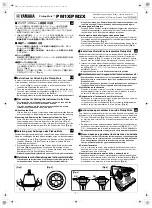
UM-0085-B09
DT80 Range User Manual
Page 196
RG
Port Function
The possible settings for the host port
FUNCTION
parameter are:
•
COMMAND
(default) – the port accepts DT80 commands sent directly over the serial interface. The port will
automatically switch to PPP mode if an incoming PPP connection is detected. When the PPP connection is
closed the port will go back to accepting direct commands.
•
PPP
– the port accepts PPP connections only.
•
SERIAL
– the port is controlled by the current job, using the 2SERIAL channel.
•
MODBUS
– the port receives and processes incoming serial Modbus requests.
•
MODBUS_MASTER
– the port is used for polling a Modbus sensor device, as specified in the current job using
the 2MODBUS channel.
•
DISABLE
– the port is disabled. This setting reduces power consumption.
Temporary Settings
The Host RS232 communications parameters can also be temporarily set by the command
PH=
baud
,
parity
,
databits
,
stopbits
,
flow-control
where:
Parameter
Settings
Default
baud
is the required baud rate. Use
300
,
600
,
1200
,
2400
,
4800
,
9600
,
19200
,
38400
,
57600
or
115200
.
57600
parity
can be
N
(none),
O
(odd) or
E
(even)
N
databits
can be
7
or
8
8
stopbits
can be
1
or
2
1
flow-control
NOFC
(no flow control)
SWFC
(software flow control, i.e. XON/XOFF)
HWFC
(hardware flow control, i.e. RTS/CTS)
SWFC
These parameters may be specified in any order and all are optional. Note that the port function cannot be set using this
command.
For example, the command
PH=115200,HWFC
sets the RS232 port to 115200 baud, no parity, 8 data bits, 1 stop bit, and hardware flow control.
These settings will be reset to the
PROFILE
values by a hard reset (e.g.
HRESET
).
You can also check the DT80's current RS232 parameters using the PH command, e.g.:
PH
RS232,57600,N,8,1,SWFC
Finally, the command
PH=
will return the all host port settings to the values specified in the PROFILE.
Serial Sensor Port
Not applicable to DT81/ 82E
The DT80 serial sensor port is normally used to control serial sensor devices. It is, however, a general purpose serial
port which is largely equivalent in functionality to the host RS232 port.
The DT80 serial sensor port:
•
can be configured for either the RS 232, RS-422 or RS-485 comms standard. RS 232 supports a single point-
to-point connection; the other standards support multiple devices in a multi-drop configuration (for certain
protocols).
•
has a differential transmitter and receiver that provide for the different serial standards
•
has RTS/CTS handshake lines (RS232 only)
•
supports baud rates of 300 to 57600 baud
•
supports the serial command, serial Modbus, PPP and generic serial protocols
•
does not provide any modem control functions
















































